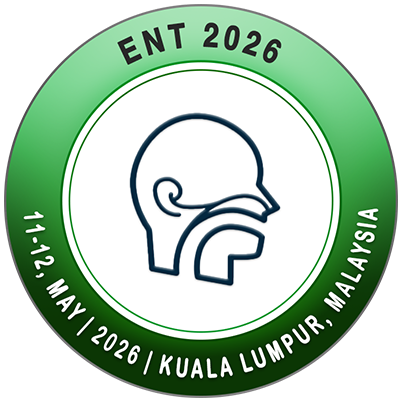
Justine Ruth Chny Tsai
East Avenue Medical Center, PhilippinesPresentation Title:
Assessment of vocal cord function using transcutaneous laryngeal ultrasonography: A tertiary government hospital experience
Abstract
Objective: To determine the feasibility of surgeon-performed transcutaneous laryngeal ultrasonography (TLUS) in the assessment of vocal cord function as an alternative to rigid laryngoscopy. Specific Objective: To describe the method of using ultrasound in assessing vocal cord mobility. To describe maneuvers that can be performed to assess laryngeal function during transcutaneous laryngeal ultrasonography (TLUS). To describe the utility of TLUS as an alternative to fiberoptic laryngoscopy in assessing vocal cord mobility for otorhinolaryngology-head and neck surgery practitioners during the time of COVID-19 pandemic. Subjects: Twenty-six patients aged between 19 and 68 years old, diagnosed with a benign or malignant thyroid disease, were seen in the Department of Otorhinolaryngology-Head and Neck Surgery subspecialty clinic in East Avenue Medical Center from November 2021 to August 2022. All patients underwent TLUS performed by the lead investigator and rigid laryngoscopy performed by otorhinolaryngology-head and neck surgery (ORL-HNS) surgeons in the same institution. The laryngeal ultrasound recordings are presented to four blinded ORL-HNS practitioners, who have all attended Head and Neck Point of Care Ultrasound (POCUS) hands-on workshops, for interpretation to assess the mobility of the vocal cords. Results: Of the 184 normal-functioning vocal folds, TLUS assessed 175 correctly. Of the 24 malfunctioning, either paretic or paralyzed vocal folds, TLUS identified 22 correctly, with a sensitivity of 91.6% and specificity of 95.1%. Of the 24 malfunctioning vocal fold presented to the blinded ORL-HNS practitioners, 12 were paretic and 12 were paralyzed based on rigid laryngoscopy assessment. Of the 12 paretic vocal fold, TLUS assessed 7 correctly for a specificity of 91.9%. Of the 12 paralyzed vocal folds, TLUS assessed 7 correctly for a specificity of 93.6%. Conclusion: We found that TLUS may serve as a reliable alternative screening tool for ORL-HNS practitioners in assessing vocal fold mobility. It can be used to differentiate paralyzed and paretic vocal folds with mastery of proper technique as image acquisition is highly operator-dependent, even for surgeon operators.
Biography
Dr Justine Tsai has obtained her Doctor of Medicine degree from Ateneo School of Medicine and Public Health. She finished her Otorhinolaryngology Head and Neck Surgery residency training at East Avenue Medical Center, Philippines. She recently completed her Fellowship training in Head and Neck Oncologic Surgery and reconstruction under Prof. Shing-Po Hao from Shin Kong Wu Ho-Su Memorial Hospital, Taiwan.


